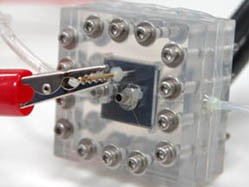By Marlys Amundson
Electrical engineering professor Francis (“Frank”) Chen is proof that retirement doesn’t mean you stop working. Twelve years after retiring, he has conceptualized, designed, and built a new machine for plasma etching and coating that is more efficient than current models.
Plasma generators are routinely used in industry for fabricating circuits with exacting precision and for coating materials. Helicons, a type of electromagnetic wave, produce high density plasmas that are useful for flat-panel displays, optical coatings, solar cells, and web-coating for packaging.
 However, the space and power requirements for helicon sources have prevented their wide-spread use because of their additional cost and complexity in comparison with other RF plasma generators.
However, the space and power requirements for helicon sources have prevented their wide-spread use because of their additional cost and complexity in comparison with other RF plasma generators.
“Though single sources can handle the etching of computer chips,” commented Chen, “large surfaces such as flat-panel displays can be covered only with multiple sources. Since helicons can produce ten times more plasma than other sources, they would be more energy efficient. But a large helicon source would require a huge electromagnet. We have found a way to use small, strong permanent magnets to do the job.”
A helicon wave absorbs RF energy and creates plasma. The plasmas produced are not the tiny plasmas in each pixel of a plasma TV, but are large plasmas able to cover the large sheets of glass used to make LCD computer and TV displays. In the future, the transistors and conductors in these displays can be etched with much less polluting effluent if plasma is used.
Chen and graduate student Humberto Torreblanca used a program developed by the late UCLA adjunct professor Donald Arnush to compute the plasma fields and determine the optimal size and shape of each plasma tube. The new system reduces the complexity of helicon designs by replacing the large, heavy electromagnet with an array of doughnut-shaped permanent magnets.
“It’s the first plasma source designed with theory,” said Chen, “not trial and error. By being able to calculate the interaction of the magnetic fields with the helicon waves, we could design an array of tubes to produce a smooth plasma treatment of a large surface.”
Chen and Torreblanca have designed a helicon source that creates plasma in the remote, reverse field of the magnets. By adjusting the spacing between the magnets and the plasma tubes, the field can be controlled to give the best helicon discharge. For applications involving large substrate areas, such as web-coating, multiple sources can be deployed to advantage.
Covered with coiling cables, the first arrangement was dubbed Medusa by Chen for its resemblance to the mythical figure. The redesigned arrangement, Medusa 2, is more compact and uses a single custom transmission line to power and water-cool the multiple antennas.
The system’s high plasma density and uniformity and its compactness for the area covered make it very appealing to industry. Chen is already in talks with companies in Taiwan and Arizona to use the new plasma generator for coating of eyeglasses and plastic food wrappers.
Before becoming interested in developing better plasma sources for industry, Chen had focused on plasma for controlled fusion energy.
